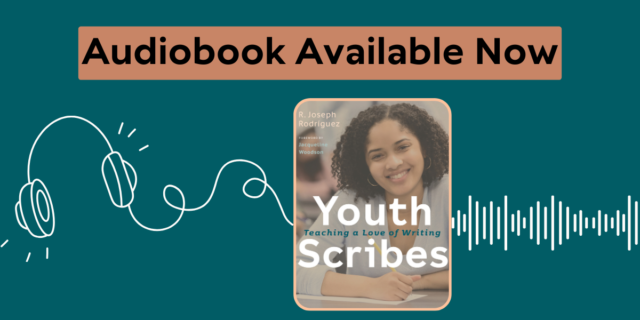
The following is an adapted excerpt from Youth Scribes: Teaching a Love of Writing by R. Joseph Rodríguez.
***

My earliest teachers made sure I could hold a pencil in my hand when I preferred other things to do. I wanted to play, sing, and socialize. But there was writing to do! I needed to keep going across the page with the pencil, making marks and scribbling my way to words in the two languages of my life: Spanish and English. My classmates were also scribbling and could tell many stories about what they had scribed on the page. Together we described what we were doing in joyful conversation with our teachers. Our teachers anticipated our best, which seemed to be their mantra when it came to creating and writing, and we were guided by their instruction and encouragement. As the years progressed in my schooling, I learned how to use more tools: crayons, paste, jumbo pencils, scissors, chalk sticks, maps, markers, Apple® IIe computers, pens, ten-key calculators, typewriters, and keyboards. Each of these tools allowed me to transform language into something for myself and also for an audience—something with a purpose and message of my own. Writing became more joyful and livelier when I was invited to write, encouraged to imagine, and supported to create. In these moments, I became a scribe.
Scribes vs. Writers
The ancient Egyptian word for scribe contains the duality of “to write” and “to draw” and has had varied interpretations throughout time periods. Niv Allon and Hana Navratilova explain that “the term invites a greater variety of interpretations, including author, copyist, literati and literate” (2017, 1). Over the years, I have read about the role of scribes in civilizations and cultures that started with the apprenticeship of boys and girls in early adolescence and reached a revered or royal status for many. Scribes held a significant role in many civilizations that formed in Mesopotamia, Africa, China, India, and Mesoamerica. Scribes possessed multilingual versatility and were held in high respect based on their education, profession, and status, such as the tlahcuiloh in Mesoamerica. Their knowledge across disciplines also influenced the study of holy prayers, scriptures, and texts and informed additional responsibilities. As a teacher of language arts, I think about the multimodal literacies my students possess with acumen and versatility and how their practices today resemble the role of scribe.
When I use the word scribe, I am referring not only to the ancient practices that predate the printing of writing and the creation of manuscripts and maps, but also to modern forms of communication that call for editing, transcription, and interpretation to show understanding across various audiences, cultures, disciplines, modes, and situations. Writing is the act, while scribing is in the purpose behind the act. For instance, scribes and cartographers, or mapmakers, appear in civilizations and societies across time—from BCE to CE. As teachers, we can cultivate our students’ scribal identities by inviting them to engage in conversations about their choices, doubts, ideas, and questions with a necessary and valid purpose. Teachers of youth scribes bring students’ literacies and their knowledge and meaning-making to the forefront of their lives to gain justice, learning, and understanding.
Why not then just use the word writer or mapmaker?
There are habits of writers we use daily, and there are also ancient habits and practices we know from various civilizations and cultures that honor and value the role of the scribe in society. Examples of the pivotal roles of scribes surround us and appear in some of the earliest communities. We can invite, access, and value students’ backgrounds and prior knowledge and experiences—inside and outside of our classrooms.
As teachers, we can guide our students to a love of writing that is cultural, essential, just, necessary, and timeless. As we teacher scribes compose beside our youth scribes, we can guide scribal acts, behaviors, and habits that can build our students’ scribal identities. In Teaching: A Life’s Work, Sonia Nieto and Alicia López Nieto explain, “Writing also helps us learn about our students [ . . . ] to look into our students’ hearts and minds and learn what’s important to them” (2019, 112). But how do we get scribes to believe in their discoveries, ideas, and ingenuity?
***

A framework for building adolescents' identities as scribes--writers from diverse backgrounds, cultures, and interests who write from their lived experiences. How to transform reluctant writers into students who want to write as translators and interpreters of their culture.


